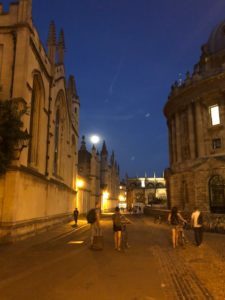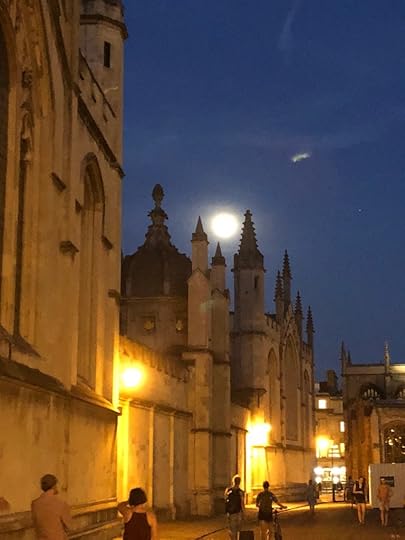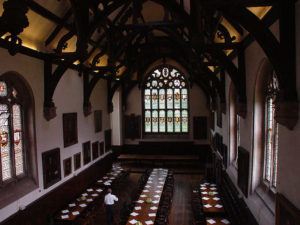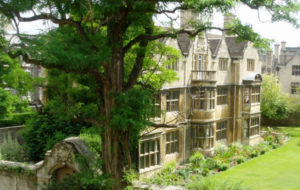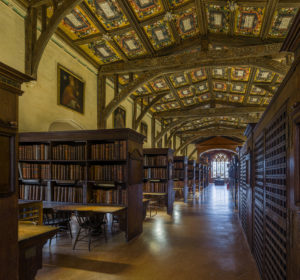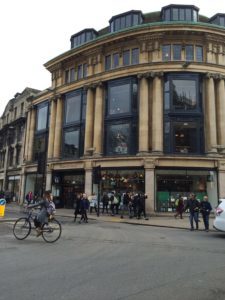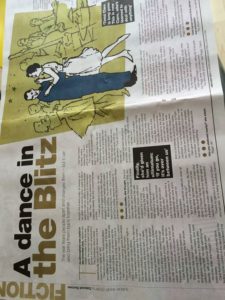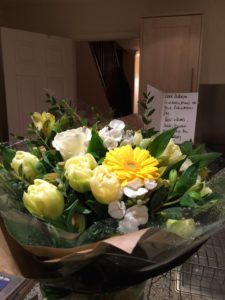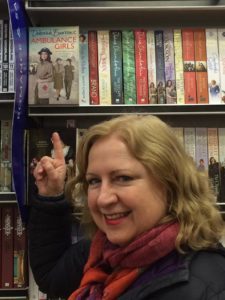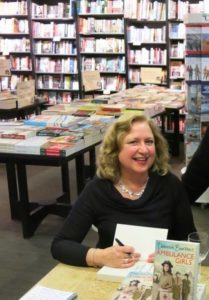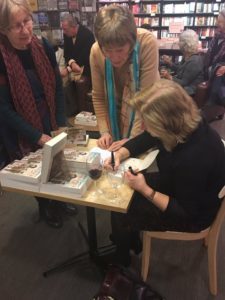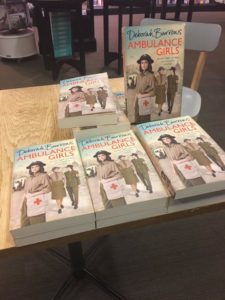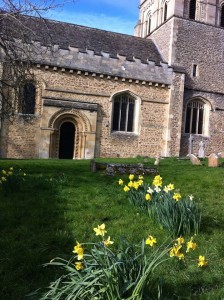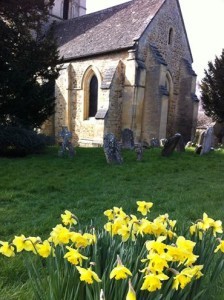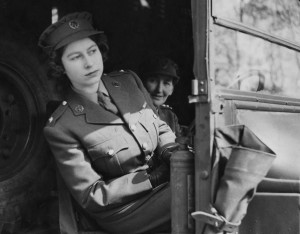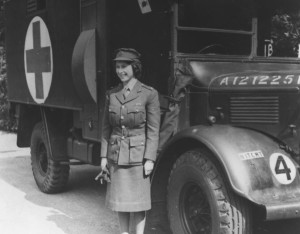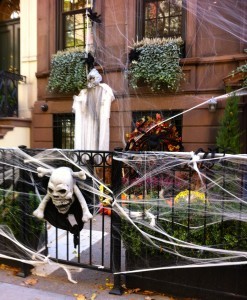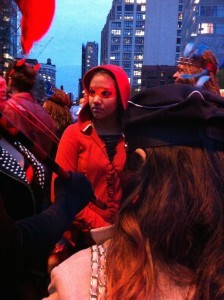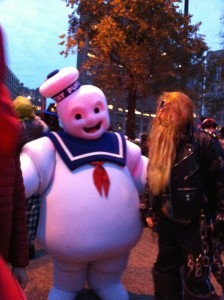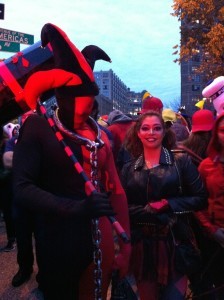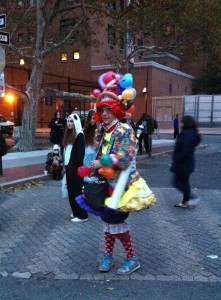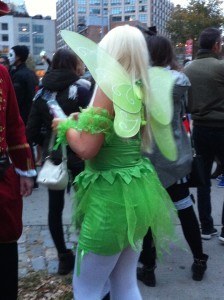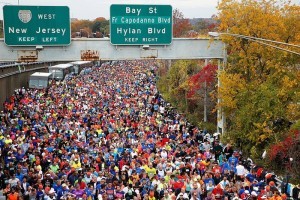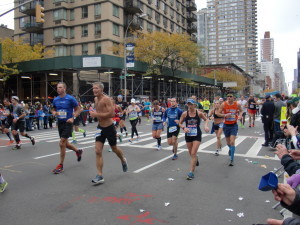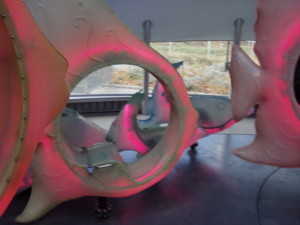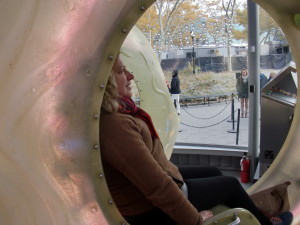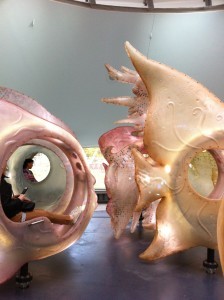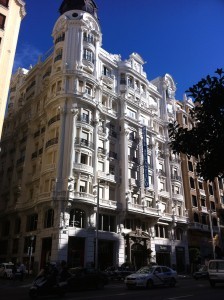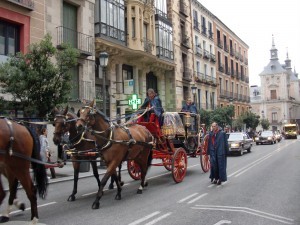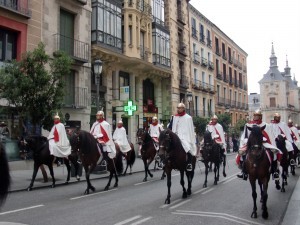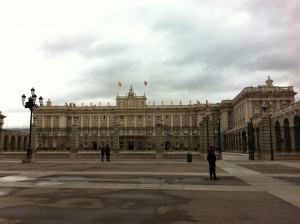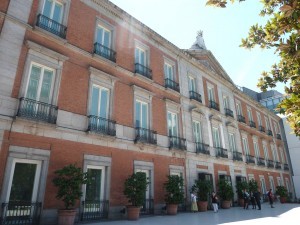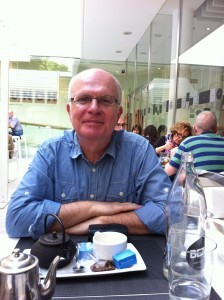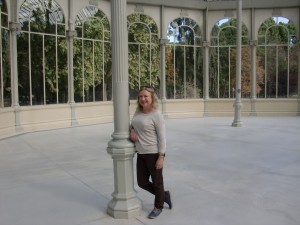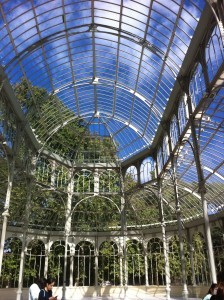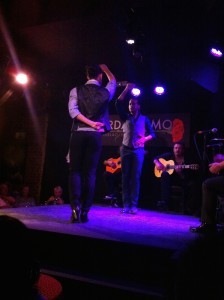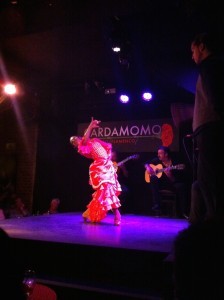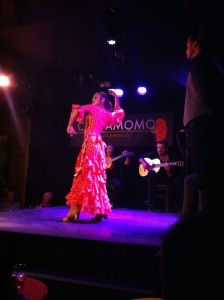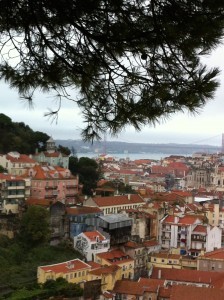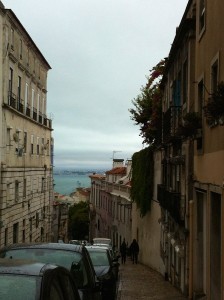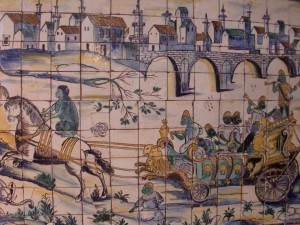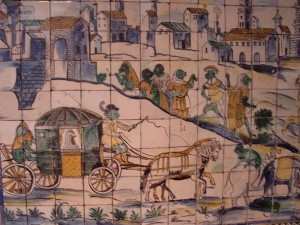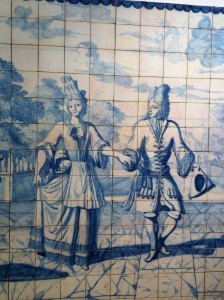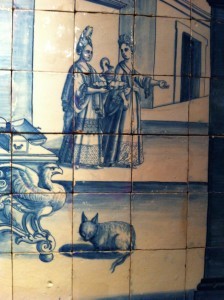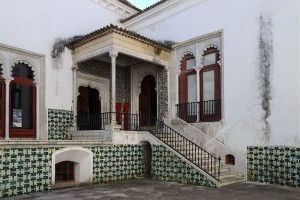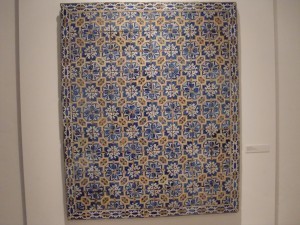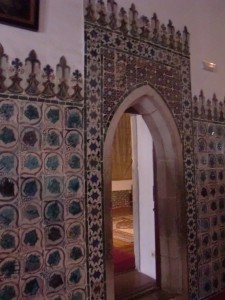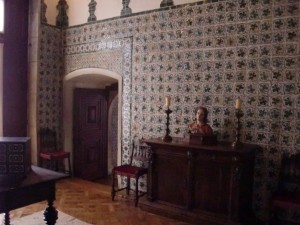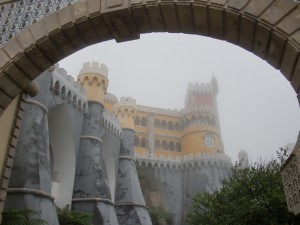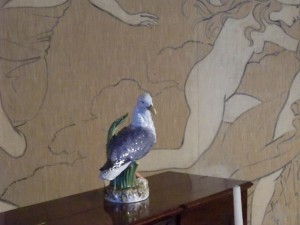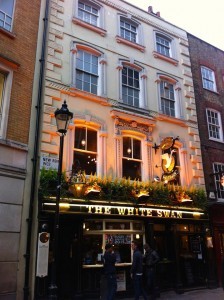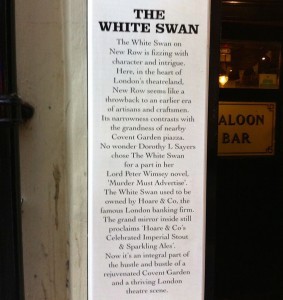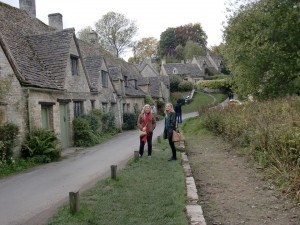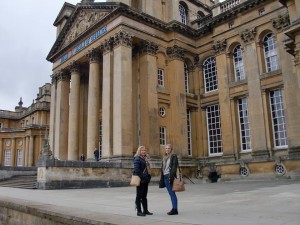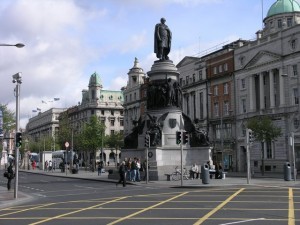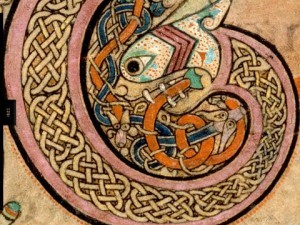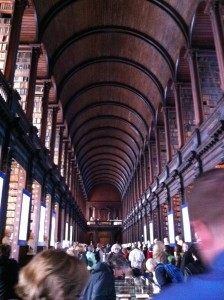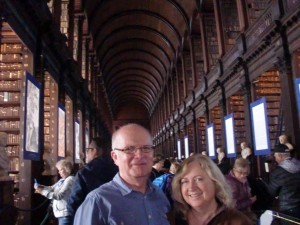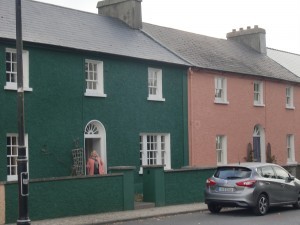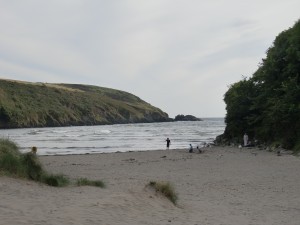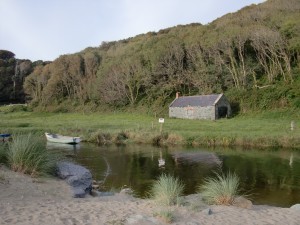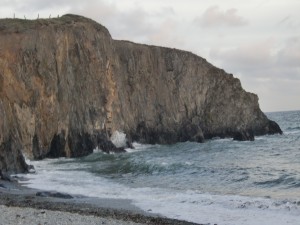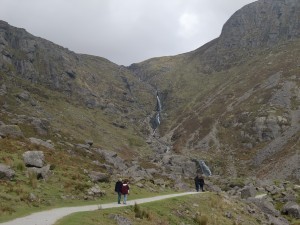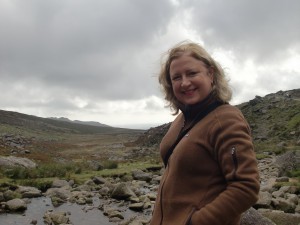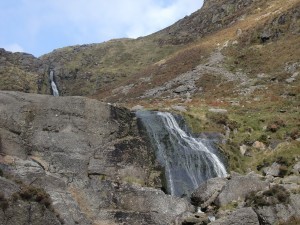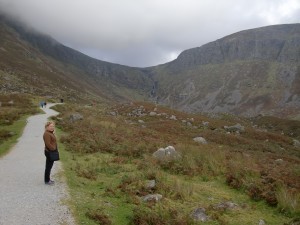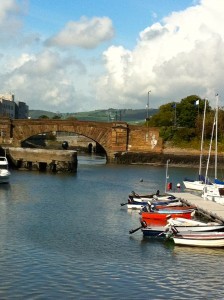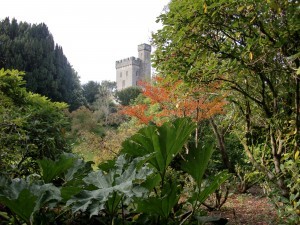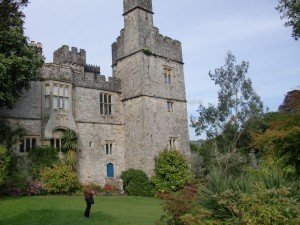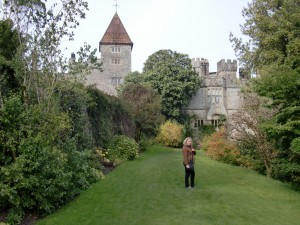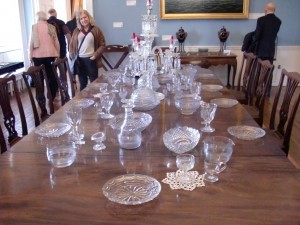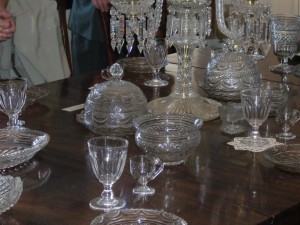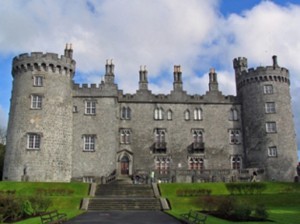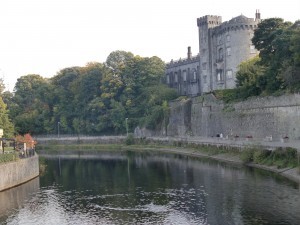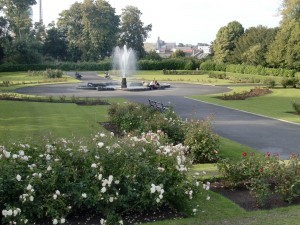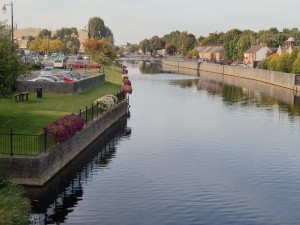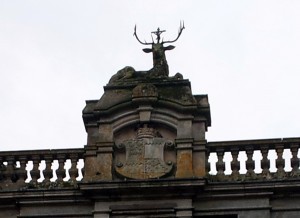Deborah Burrows's Blog
October 9, 2019
The writer and the codebreakers
I have a soft spot for a good mystery. My first three books A Stranger in my Street, Taking a Chance and A Time of Secrets were all ‘whodunnits’ set in WW2.
Which is why I was delighted to attend the inaugural Capital Crime Writing Festival in London last week.
The first session I went
to was “The Influence of Agatha Christie”. Like many
authors, I remember reading an Agatha Christie as my first ‘grown-up’ book.
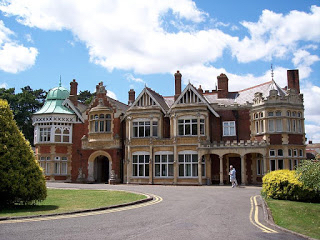 Bletchley Park House
Bletchley Park HouseListening
to the panel reminded me of a time in WWII when the Queen of Crime was
suspected of using one of her books to send coded messages to the Nazis.
It relates to the codebreakers at Bletchley Park near Milton Keynes, which is one of my favourite museums.
During WWII a small
group of code breakers at Bletchley Park developed techniques for decrypting
messages coded using electrical cipher machines that the Germans considered
‘unbreakable’. The flood of high-grade military intelligence deciphered by
Bletchley Park was code-named Ultra.
 Colossus machine
Colossus machineThe messages included information about German spies in the UK, which
led to the capture of every German spy in the country. Most became
double agents under the British Double-Cross Operation and were used to
disseminate false intelligence to the Abwehr (German Military Intelligence).
It is estimated that the codebreakers at Bletchley Park shortened the
war in the Atlantic, the Mediterranean and Europe by between 2 and 4 years and may even have altered
its outcome.
It was crucial that the enemy remained wholly
unaware of the work being done at Bletchley Park.
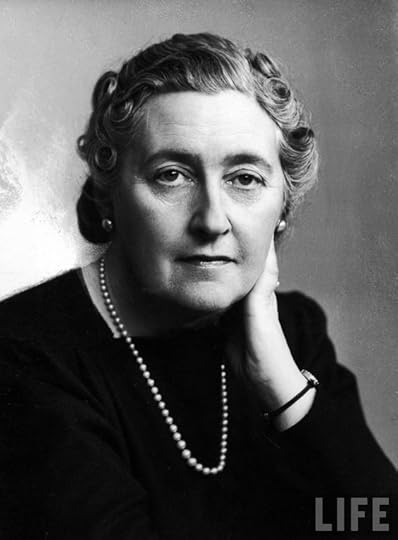 Agatha Christie – Queen of Crime
Agatha Christie – Queen of CrimeAt the same time that the Bletchley Park
codebreakers rushed to break the German Enigma code, Agatha Christie was
writing her first spy thriller.
In N or M, which was published in 1941, the daring
detective pair, Tommy and Tuppence Beresford, are recruited by British Military
Intelligence to discover the identity of a German spy. An important character in
the book is Major Bletchley, an annoying retired Indian army
major, who professes to have inside knowledge of the war.
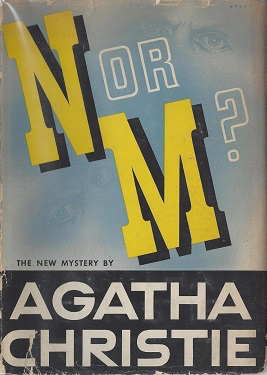
Like all Christie’s books it was a best-seller, but it caused consternation
in MI5. Was Christie sending a message in the novel, letting the enemy know
that not just the fictional Tommy and Tuppence, but also MI5 were unmasking
German agents? Was she divulging that “Bletchley” was significant in this?
Or was it all just a strange coincidence?
Agatha Christie was ‘the Queen of Crime’. If MI5 agents or the police went
to interrogate Christie about her choice of character name, it might bring
damaging publicity.
MI5’s Chief Cryptographer at Bletchley Park was
Alfred Dillwyn “Dilly” Knox, who was a close friend of Agatha
Christie. MI5 had a word with him about it. Although he considered it
laughable that Christie knew anything at all about what was going on at Bletchley
Park, he agreed to talk to her.
He did so in a very British manner. Over tea and scones at his home in
Buckinghamshire, Knox asked Christie in a light-hearted manner how she arrived
at the names of the characters in her books. Major Bletchley, for instance, in
her latest novel.
 Bletchley Station
Bletchley StationChristie gave an innocent explanation. She had been stuck at Bletchley Railway Station, on her way by train from Oxford to London. Annoyed at the long delay, she took revenge by giving the name Bletchley to one of her least loveable characters.
Knox reported back to MI5, who were apparently reassured by this
explanation.
And yet…
In the 1940s the route of the (now defunct) “Varsity Line”
between Oxford and Cambridge went through Bletchley. But Christie said she was
on her way to London. Why would she go to Bletchley when there was a direct
Oxford-London line she could have taken?
She may have had no choice. German bombings meant the UK railway service
was in a parlous state at that time. Diversions and long delays for
non-military transport were common and very irksome to travellers. Christie’s
explanation for using “Bletchley” may be the simple truth.
But there is another, very interesting facet to the story. During the Second World War, and when she was
writing N or M, Christie lived at the Isokon building in Hampstead, an
avant-garde 1930s apartment building.
 Isoken Building
Isoken BuildingI have visited the Isokon, in which reinforced concrete was used in
British domestic architecture for the first time. It was designed for
well-heeled tenants who wanted a minimalist lifestyle with few possessions and who
didn’t like cooking. The apartments had no kitchen, but food could be ordered
from a general kitchen on the ground floor.
The tenants it attracted included around twenty-five Soviet Russian spies,
who lived there between the mid-1930s and mid-1940s.
In fact, one of Christie’s neighbours was Arnold Deutsch, the controller
of the infamous spy group of Kim Philby, Guy Burgess, Donald McLean and Anthony
Blunt.
The Isokon is not a large building and Christie must have known her
neighbours. Was it co-incidence that while living there, she first tried her
hand at a spy novel? Or did Christie overhear something in the Isokon
that provided the seed for her spy story?
Was it coincidence that she should give a character in that novel the
name of the top-secret establishment where British codebreakers led by her
close friend were deciphering Nazi messages, including those relating to German
spies in Britain? Had Dilly Knox himself innocently mentioned
Bletchley Park in Christie’s hearing? Or was the railway station story the
truth. Or was it a mixture of the two?
J.R.R Tolkien is quoted as saying that a story:
grows like a seed in the dark out of the leaf-mould of mind: out of all that has been seen or thought or read, that has long ago been forgotten, descending into the deeps.
J.R.R. Tolkien
I’m sure Christie herself had no idea how, but the name “Bletchley”
allied to the idea of German spies slipped into the leaf-mould of Agatha
Christie’s mind and took root there.
August 12, 2019
Blowing up bridges in France
The book I am
writing at the moment is about the ‘Resistance Girls’ of the Special
Operations Executive (SOE) an organisation set up in WW2 by Churchill to ‘set
Europe ablaze’ by sending agents into occupied Europe to organise resistance
groups and engage in sabotage against the Nazis.
The Allies sent more
than four hundred agents into occupied France, of which 39 were women. The
‘Baker Street Irregulars’ as they became known, were trained in sabotage, small
arms, radio and telegraph communication and unarmed combat. SOE agents were
also required to be fluent in French so they could fit seamlessly into French
society.
All the agents knew
the risks and were told that they had no more than a 50% chance of survival in
occupied France.
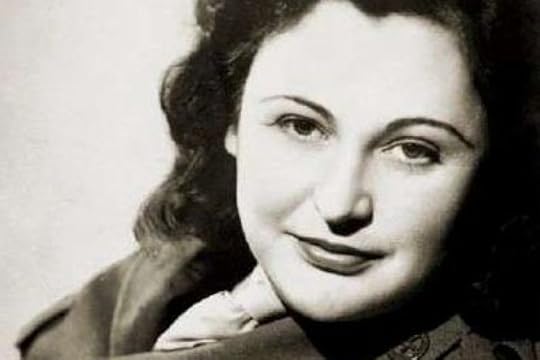 Nancy Wake
Nancy WakeThe women agents
were mostly couriers or wireless operators, although some, such as NZ/Australia’s
Nancy Wake, America’s Virginia Hall and British Pearl Witherington led maquis
(guerrilla) groups of up to 7,500 strong and were personally involved in attacks
on bridges, railway lines, and German convoys. They also underwent
extensive training in resisting interrogation and how to evade capture. Sadly, sixteen
women did not survive the war: thirteen were executed at Ravensbruck,
Bergen-Belsen, Dachau or Natzweiler-Struthof concentration camps.
The stories of the SEO’s “irregular” women
are stories of courage, daring and sacrifice and it is an honour to write about
them, even if in a (slightly) fictionalised account.
 The old gate in Castillon
The old gate in CastillonI find it difficult to write about places
I’ve not been to, walked around and got to know a little. I need to know how
the air feels, the strength of the sun, how light reflects off the houses, the
scents, the terrain, the trees, flowers – the general ambiance.
And so, in April we spent 9 days in south
west France, where my heroine will be sent to work as a courier in 1943. We
stayed mainly in a small town called Castillon de Bataille, which overlooks the
Dordogne River. I wandered around taking masses of photos of little alleyways
and rooftops, to figure out how my heroine could avoid German patrols, and
where her ‘safe houses’ might be.
 Castillon rooftops
Castillon rooftopsOur home was Chez Castillon, a tall house that
is a Writers’ Retreat. There were nine guests, either (like me) writing and
sightseeing, or taking a writing course. Janey and Mickey who run the place are
both actors, although Janey now spends her time writing. Janey served up three
delicious meals a day and we had Bordeaux wine every lunch and dinner. It was
fab.
Castillon de Bataille is in the middle of
the Bordeaux wine country. The town’s claim to fame dates from 1453, as it is
where the last battle of the Hundred Years war was fought.
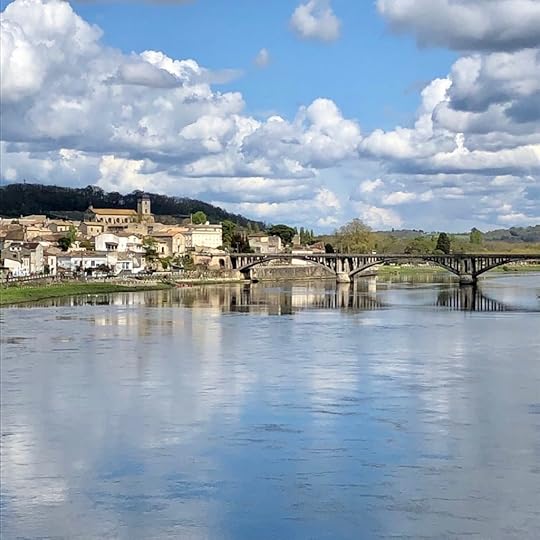 Castillon Bridge
Castillon BridgeIn WW2 it was called Castillon sur Dordogne
and was on the frontier between occupied and Vichy France and Chez Castillon
was a hospital for German officers. There is a plaque on this bridge that marks
the former demarcation line.
I’m going to blow up that bridge! … in the
book…
One day we visited the medieval town of Saint-Emilion, and rode the little bus around the Chateaux. And so, the first scene of the new book takes place just outside Saint-Emilion and in another scene there will be a chase through scrub and through steep, narrow cobbled streets.
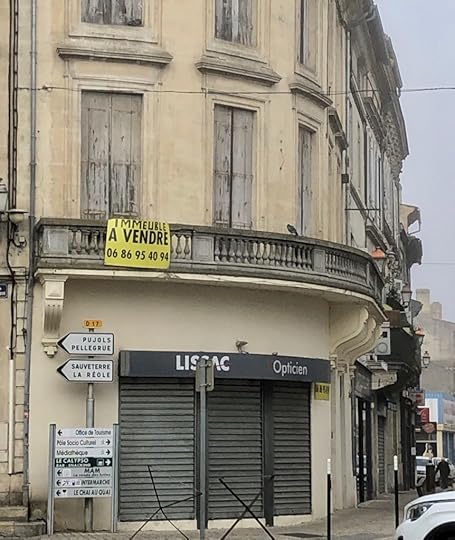 Balcony for collaborateurs
Balcony for collaborateursBut I’m not sure if I’ll include this: when
Castillon was liberated, as in the rest of France, ‘collaborateurs horizontales’
(women who’d been too friendly to the German soldiers) were rounded up, their
heads were shaved and they were painted with tar. The women from Castillon were
put on show on this balcony which overlooks the main square.
They got off better than those at a village
down the road, where they were shot… according to our host, Mickey.
We finished the holiday in beautiful
Bordeaux, where I again scoped out scenes for the novel. Unsurprisingly, I came
back full of ideas for the new books.
June 25, 2019
My father’s war
Recently we celebrated Father’s Day in the UK. In Australia it is celebrated on the first Sunday in September.

I have one memory only of a Father’s Day spent
with my father. That year it was also his birthday and I remember telling
people in our street about this amazing coincidence.
It was Sunday 1 September 1963 and I was
four and a half years old. My handsome war hero father with the Errol Flynn
moustache had just turned 42.
Seventeen days later he was dead.
His experiences during the war as one of the 2nd Independent Company (later the 2/2nd Commando Squadron) had caused in part his fatal heart attack.
The story of the 2/2nd is a compelling one.
When the Japanese invaded Timor in February 1942 the commandos were wholly cut
off from supplies and support from Australia and massively outnumbered, but
they continued to fight.
Little known but great in spirit are the men of Timor. They alone did not surrender.
Winston Churchill
I have Dad’s war diary, which gives me a
tangible link to the events.
My father, Jefferson Williams, was nineteen
when he joined the Australian Army on 21 May 1941. While still in army training
camp he was intrigued by a call for soldiers to join a secret group.
It was voluntary to join and its
secretness aroused my curiosity and I joined. We were not told anything other
than we were to receive special training.
The special training took place at the
Guerrilla Warfare Camp in Victoria. Dad spoke of forced marches in the
mountains, wading through swift rivers with a full pack held above his head. He
learned unarmed combat, sharp-shooting and living off the land. All these skills
later allowed him and his mates to survive against the odds.
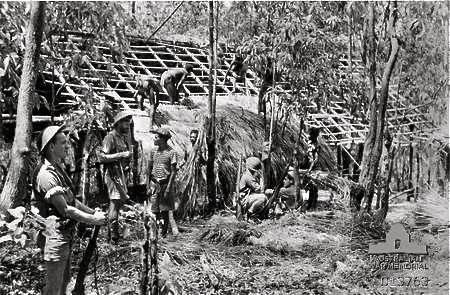 Dad in the foreground stands guard while Timorese build a bamboo hut
Dad in the foreground stands guard while Timorese build a bamboo hutTimor lies only around 400 nautical miles from the Australian coast. Fearing the Japanese advance, Pacific Command sent the 2/2nd to Timor on 8 December 1941 as part of “Sparrow Force”.
Singapore fell on 15 February 1942. The commandos
grimly prepared for Japanese invasion by burying stores of ammunition and other
equipment at secret dumps and walking barefoot to toughen their feet against
the day their boots gave out.
Four
days later, 6,000 Japanese troops landed on east and west Timor.
The following day, Dad wrote in his diary:
This morning looking out to sea, we behold 4 ships. So far, their identity is unknown.
Then:
They were Japanese ships. 2 Destroyers and 2 transports.
At 1400 hours:
The Japs have taken Dilli. There are 5,000 Japs in Dilli ... This morning ... 14 men of 7 section and two others went into Dilli in the utility truck. The worst is feared for these men, also Pinocchio, the motor bike mechanic [who] passed us bound for Dilli. He is gone, I think. We are back in the mountains. ... “A” Platoon is, or was, down on the aerodrome. I wonder what has become of them. There are some Japs in the hills looking for us. They will have a job getting us.
That last sentence was quite the
understatement.
Some days later Dad wrote:
The 16 men who went into Dilli by truck were tied up and machine gunned. 2 escaped. One is nearly dead and the other wounded but OK.
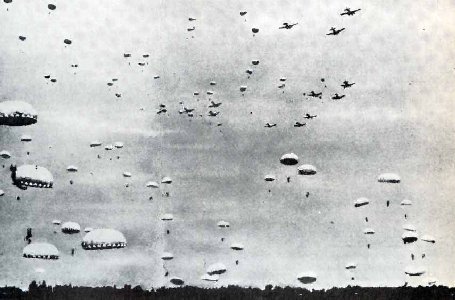 Japanese paratroopers land in Timor
Japanese paratroopers land in TimorThe massacre of the men on the utility truck was one reason why the 2/2nd never considered surrender. All the other Australian forces on the island did surrender (after brave and intense fighting), although some of the 2/40th joined the 2/2nd in the hills.
Numbering around 300, the Australians faced
a force of 6,000 Japanese. But morale was high, they had a large reserve of
ammunition and they were specially trained for commando-style operations. Without
realising it, these “men of Timor” had become the only Australian force still
in action in enemy territory after the Japanese conquest of south-east Asia.
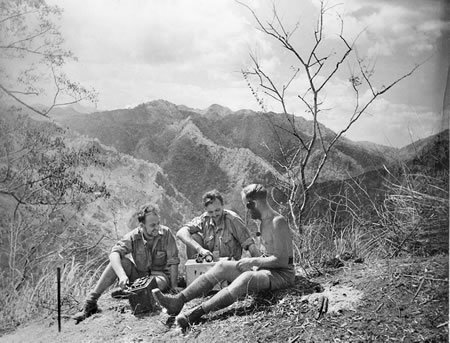 Winnie with operators
Winnie with operatorsAustralia thought they were all dead or
captured. Eventually, they cobbled together a wireless transmitter (“Winnie the
War Winner”) on the back of a kerosene tin and on 19/20 April 1942 they radioed
Northern Force HQ in Darwin.
At first it was thought to be a Japanese ruse. HQ asked questions: could Captain Parker provide the street number of his house – “yes, 94”; could Jack Sargeant give his wife’s name – “yes, Kathleen”. Then:
“Sparrow Force, what is your situation?““Force intact. Still fighting. Badly need boots, quinine, money, and Tommy-gun ammunition.“
The news that the 2/2nd was intact and still
fighting the Japanese was tremendously valuable, both strategically and in
terms of morale for Australia. It arrived at the country’s darkest hour, after
Japanese victories in Malaya, the Philippines, Rabaul and the Dutch East
Indies. The small band of ill and war-weary men became overnight heroes.
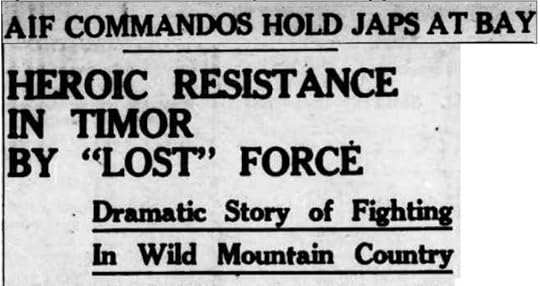 News headline in Australia
News headline in AustraliaMore importantly, they received supplies by
parachute and boat.
Today we were issued with the first lot of comforts which are very few, but very nice. I received 1 tooth brush, cake soap, handkerchief, 1 ounce tobacco, 1 pkt papers, and some shaving soap. As we were out of everything, I also received a pair of boots. All these things were dropped by parachute.
Sailors who delivered supplies at first assumed
the gaunt, haggard, bearded men dressed in rags were local mountain tribesmen,
not Australian soldiers.
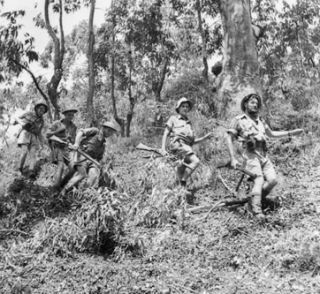 On patrol – Dad at the the rear
On patrol – Dad at the the rearThese men drove the Japanese forces to
desperation by inflicting damage on them wherever and whenever they could.
General MacArthur ordered the 2/2nd to
remain on Timor and continue the campaign of ‘harassment and sabotage’ against
the Japanese. Despite battle-wounds, malaria, beri beri, dystentery and other
tropical ailments, they did so.
The natives around Dilli say we are Lubic (Gods) and we come up out of the ground, kill Japs and then disappear back into the ground. It must seem like that, as in the last 6 raids, not one Jap has seen an Australian. The natives say that the Japs are pretty scared of the Australians.
On 1 September 1942, Dad turned 21.
We now have prices on our heads. A private is worth $50, 2IC $500, Major Spence and the Colonel $5,000. $1.00 is worth 1/8, so we are pretty valuable. The Japanese are offering this to the Timor natives for each Australian they capture, dead or alive.
By November 1942, the 2/2nd, reinforced with the 2/4th Independent Company from Australia, numbered only 700 men, and yet were able to tie down over 30,000 Japanese soldiers.
But when the Japanese began exacting savage
retribution on any Timorese who helped them, the situation became untenable. In
late December 1942, the commandos were ordered home.
The
Timor commandos played a crucial role in the war, by tying up thousands of
seasoned Japanese troops while the battle for Kokoda hung in the balance.
By the end of the war, the 2/2nd had been
in contact with the enemy longer than any other unit in the Australian Army.
As my father said to renowned documentary film maker, Damian Parer, who filmed Men of Timor in November 1942:
There’s no doubt we’ve got the pick of Australia in this bunch. It’s not just because I’m one of them myself.
jefferson williams
May 16, 2019
Growing up in the wild west
The second Sunday in May is ‘Mothers’ Day’ in Australia. My
darling mother died on 28 August 2011, at the ‘ripe old age’ of 91 years. I
still miss her.
Mum spent her childhood in the Western Australian mining town of Kalgoorlie.
She always said that Kalgoorlie bred special people. They
certainly had to be hardy. Founded in 1889 it became known as Western
Australia’s “Golden Mile”, “the world’s richest square mile of
earth”.
During the 1890s, the area boomed, with a population
exceeding 200,000, mainly prospectors chasing gold. The area gained a notorious reputation for
being a “wild west” with bandits and prostitutes.
It was around this time that my mother’s family arrived from
Goulburn in New South Wales and set about making Kalgoorlie their home. Mum’s grandfather, Richard Everett, was a
builder who brought six of his children aged 10 to 23 with him to the frontier
town, including Louisa, my grandmother. As they were teetotal Methodists, I
think it is fair to say they would have had a culture shock.
Although the first electric trams ran in 1902, it wasn’t
until 1903 that the ‘golden pipeline’ was completed, pumping 23,000 kilolitres
(5,100,000 gallons) of water per day from Perth.
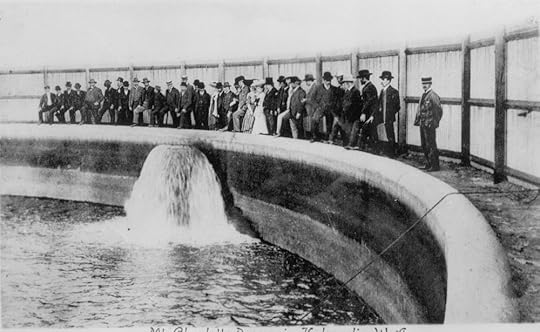 When the water came to Kalgoorlie in 1902
When the water came to Kalgoorlie in 1902My grandfather, James Eastwood, was an accountant from
England who met the Everett family in Perth when they were on their way to
Kalgoorlie. He fell hard for Louisa, threw over his job and followed her to
Kalgoorlie.
James and Louisa married in 1903. The house James built for his
bride wasn’t fancy but has lasted for over a century and is still occupied.
My mother was born in 1920, very much the youngest of five
sisters, after her father returned from WW1. When she was only eighteen months
old James died. With no widow’s pension Louisa took in a lodger and returned to
dressmaking.
 Archina Sinclair Campbell Everett
Archina Sinclair Campbell EverettDespite having little money, Mum had a happy childhood,
surrounded by aunts, uncles and cousins. Her adored “little Grannie”, Archina Everett
(4’ 11” tall) came to live with them for the last 10 years of her life, after
becoming blind with glaucoma. Archina was an old-school Scottish Presbyterian and
to Mum’s amusement, insisted on calling Kathleen, Mum’s older sister, “Katherine”.
Why? “Because “Kathleen’s too Irish”.
On Sunday afternoons one of Mum’s two uncles, Wilfred and
Victor (who had a carrier’s business) would take Archina out for a “jaunt” in a
horse and sulky. Grandma’s “going out” outfit was a long black sateen dress,
little black boots (she was born with a club foot) and a black cloche hat
trimmed with black lace.
As Mum’s cousins were Methodist, she always gate-crashed the
Methodist Sunday School picnic, which apparently had the best games and cakes
of all the Sunday school picnics.
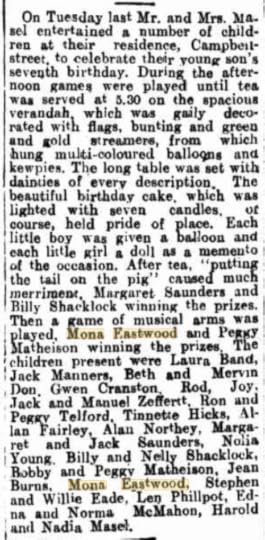 Kalgoorlie Miner – Saturday 31 December 1932
Kalgoorlie Miner – Saturday 31 December 1932Aunt Edie’s Sunday “teas” for the whole extended family were
spectacular. Cold meats and salads, fruit salad, jelly and ice cream and all
varieties of scones and cakes would be laid out on a large table on their side
verandah. After tea, there would be sing-songs around the pianola.
Mum (who was always called Monnie, not Mona) was a bright child and was put up a grade at North Kalgoorlie Primary School. A tiny girl, with skinny legs encased in the black stockings, her nickname was “Minnie Mouse”, which she hated. But she had many friends and an active social life, attending parties, sports events and ballet dancing, as often recorded in the local newspaper, The Kalgoorlie Miner.
Below is the Kalgoorlie Mum knew in 1930.
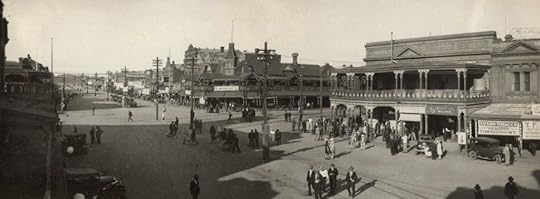
The family’s fortunes revived when Louisa inherited James’
share of his mother’s Isle of Man estate. One of her first actions was to send
Mum on a Young Australia League trip around Australia:
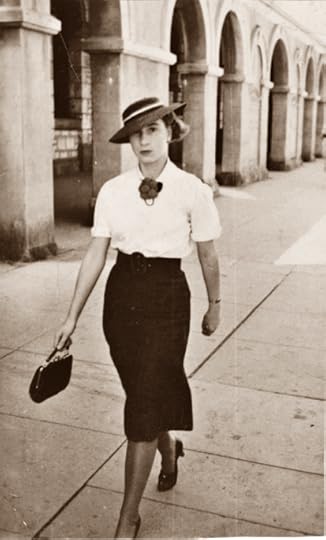
In late 1939 (shortly after the start of World War II), Mum
sat for the Commonwealth Typists’ Examination (in English, Arithmatic,
Typewriting (178 wpm) and Shorthand (191 wpm). She came top of the State, just
as her sister Marjorie had done fifteen years earlier. She was offered a job in
a Government department in Perth, and left Kalgoorlie with her mother and
sister Jean. (The other sisters had all left home and married by then.)
For a while during the war they lived in Megalong Road, Nedlands, a house that features in one of my books, A Stranger in my Street. It’s where Meg Eaton is living with her mother and sister when she discovers a body in the air raid shelter of a neighbour’s house…
July 26, 2018
The moon over Radcliffe Square and ghostly Oxford
Last night I walked back from a gorgeously funny production of Love’s Labours Lost at Wadham College. The moon was almost full (a bomber’s moon) and it seemed to be stuck in the towers of All Souls College.
Oxford is amazingly romantic at night. The day trippers have left and it is the haunt of students, Oxonians, the homeless (and hoards of teenaged foreign language students).
Romantic . . . and ghostly.
So (rather than do what I should be doing and finish my latest novel) I thought I’d share some of Oxford’s most famous ghost stories.
Wadham College
We go to the College every year to see Shakespeare performed in the lovely gardens. I’ve never seen the resident ghost, but here’s the story:
Wadham’s ghost has been observed over the years by witnesses of veracity: one head porter and two scouts. Apparently they’ve observed a white figure in robes – possibly a priest – walking from the chapel door, across first quad and into the hall, across the hall to vanish just in front of High Table. I understand that this part of the college was built over the site of an old Augustinian Priory.
Wadham College Hall
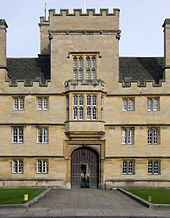 And the former Head-Steward, Mr Maurice Howes, apparently complained on a regular basis of hearing footsteps late at night from his office. They seemed to enter the hall, but never left it.
And the former Head-Steward, Mr Maurice Howes, apparently complained on a regular basis of hearing footsteps late at night from his office. They seemed to enter the hall, but never left it.Queen’s Lane
My favourite place at night is spooky Queen’s Lane, where the cavaliers rode through on their way to do battle with Cromwell’s army. Sometimes, when it is deserted, particularly on a windy autumn evening, you can hear the ghostly hoofbeats…
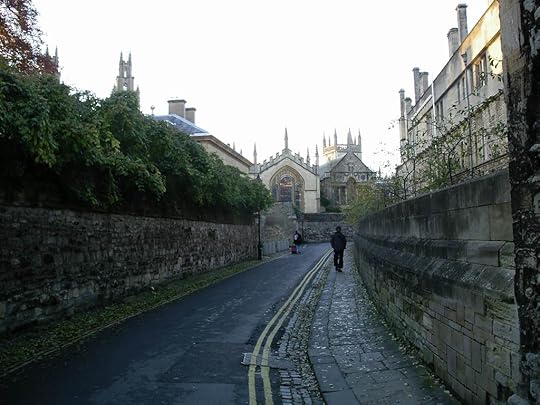
Queens Lane
St John’s College
Archbishop of Canterbury, William Laud, was beheaded in 1645, after being impeached by the Long Parliament .
(The Long Parliament lasted from 1640 until 1660, and passed, among other acts, the first Habeas Corpus Act – which as a lawyer gets me quite excited, because a Writ of Habeas Corpus provides that the Crown must “certify the true cause” of imprisonment. It’s one of the fundamentals of English and Australian criminal law).
Here’s a particularly horrible depiction of his execution 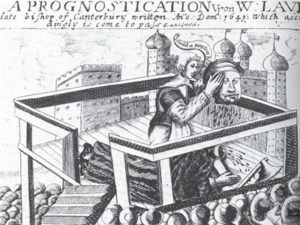
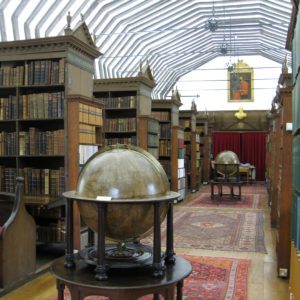
Here’s the library where he plays football with his head.
Laud was educated at St Johns, and his bones are buried under the alter of the chapel. His ghost has been known to disrupt students in St John’s College Library.
Some say he pulls his head from his neck and rolls it at people, others say he kicks it along the floor with a candle in his hand. And apparently he drifts 20mm above the ground, because the pavement has worn down since his death.
Now those who read Harry Potter will recognise the similarity to Nearly Headless Nick. But Laud looks nothing like John Cleese. In fact, I don’t think the Archbishop looks like the ghostly sort, myself. I certainly don’t see him playing football with his head. (I’ve always seen him as an honourable man, on the wrong side of history.)
Merton College
Merton College library has the ghost of poor Colonel Francis Windebank, shot in 1645 by his own side.
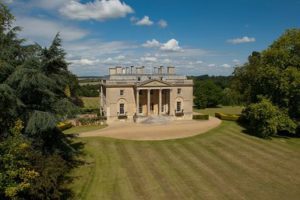
Bletchingdon Park
It’s a sad story. He was a young, newly married colonel in the Royalist army in the Civil War and was appointed governor of Bletchingdon Park, near Oxford. In April 1645 he invited his young wife and friends for a ball at the house to raise their spirits (not the ghostly kind). A Parliamentarian spy may have been present, as during the ball the house came under attack by Cromwell’s forces.
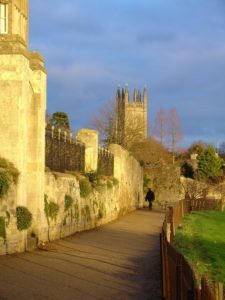
Dead Man’s Walk
The house was well protected, and probably could have withstood the attack, but Windebank surrendered immediately. It is likely that he did so in order to protect the lives of his wife and friends.
He went to explain to the King in Oxford (where the King had his headquarters). His excuses were not accepted and he was tried by a Royalist court-martial for failing to protect Bletchingdon Park. They took just three hours to find him guilty and sentence him to death by firing squad.
His execution took place against the length of town wall abutting Merton College. Windebank bared his chest to the muskets and exclaimed “God Save the King.”
Windebank’s ghost haunts the site of his execution at Dead Man’s Walk, which abuts Merton College. He’s a well known Oxford ghost, and is thought to haunt because of his lingering feeling of injustice at being executed for what he considered a chivalrous action.
It is also said that he walks around on his knees. Rational thinkers (?) say that it is more likely that he is walking on the original (lower) ground level of the seventeenth century.
I couldn’t find a picture of poor Francis, but here’s a generic Royalist Cavalier, so if you’re wandering along Dead Man’s Walk, you’ll know what to look for: 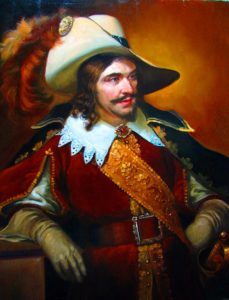
University College
The wonderfully named Obediah Walker (the ghost who walks – get it!) was the Catholic Master of University College.
He tried to follow James I into exile in France but was captured and imprisoned for ten years. When released he was a broken man and his ghost supposedly haunts Staircase VIII (where the Master’s residence used to be). I could find no photograph of Obediah, but here is the place where Walker walks…
Christ Church College
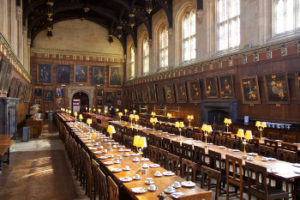
Christ Church Great Hall
Oxford was a Royalist stronghold during the English Civil War. The King made the Christ Church College Deanery his palace and held Parliament in its Great Hall.
The spirit of King Charles I has been known to appear in the grounds of Christ Church College and in the Great Hall, sometimes with his head, sometimes without.
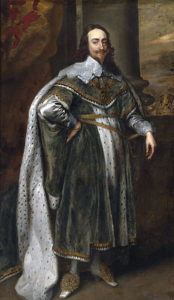
King Charles I
Apparently he also appears in the Bodleian Library. While in Oxford, the King was denied leave to take books from the Bodleian in 1645. He has been seen at night running around in the upper reading room pulling books from the shelves reading one line and placing them back in an endless game of fortune telling, again sometimes with and sometimes without his head.
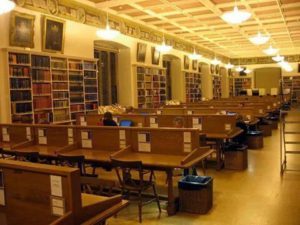
The Upper Reading Room at the Bodleian Library
And that is NOT why I always do my study in the Lower Reading Room.
Magpie Lane
The former bank that stands on the corner of Magpie Lane (now the Quad) is reputedly haunted by the ghost of Prudence, who died of a broken heart when her Cavalier lover ran away.
I’ve walked down that little lane many times, but Dear Prudence has never come out to play (you have to be a Beatles fan to get it!)

Entrance to Magpie Lane
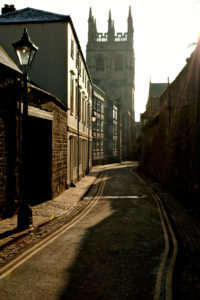
Magpie Lane in spooky mode
March 9, 2017
Back in Oxford and a book launch
It has been delightful to be back in the UK. The weather has been mild (except for an odd incident of sudden hail) and there has been sunshine! We are staying in a little townhouse off Meadow Lane, the ancient pathway from Iffley into Oxford. I love the walk – it is lined now with houses on one side and on the other playing fields or waste land that used to be the treasured water meadows of the medieval farmers. Subject to flooding and therefore impossible to use for building or crops, the fields were common land that would grow lush grass in the summer. So it would be vital for haymaking. The hay would be stored and used to feed the animals over the cold winter.
So whenever I walk the pathway (now shared pedestrian/bicycle/occasional car) I imagine the peasants plodding along with their animals, or knights on horseback.
The townhouse was very useful for us, as it is half-way between Iffley, where our friends live, and Oxford, where the Bodleian Library is located. We spent quite a bit of time in the Upper Reading Room, doing research. It still gives me a thrill to realise that I can order any book ever published in the UK and have it waiting for me within a couple of hours. The Upper Reading Room is up and up and up flights of stairs, past the entrance to the Arts End of the amazing Duke Humphrey’s LibraryThis is Duke Humphrey’s edifice:
By Diliff – Own work, CC BY-SA 3.0, https://commons.wikimedia.org/w/index.php?curid=38962663
(If you want to know about Duke Humphrey: https://en.wikipedia.org/wiki/Duke_Hu...)
The Upper Reading Room is lighter and quieter than the Lower Reading Room (undoubtedly because of the many flights of stairs). It is sobering when one is plodding up the stairs, using the rail to haul weary legs just one more step and a young student trips past, almost running.
The Upper Reading Room is remarkable for the painted freize that runs along the top of the walls. As Wikipedia says:
“The painted frieze at the Bodleian Library, in Oxford, United Kingdom, is a series of 202 portrait heads in what is now the Upper Reading Room. It was made in 1619, and the choice of worthies to include was advanced for its time, featuring Copernicus and Paracelsus as well as Protestant reformers.[1] The portraits have been attributed to the London guild painter Thomas Knight; they were taken from at least ten different sources, according to current views.[2] The frieze was painted directly onto stonework (rather than by fresco technique), and its condition deteriorated despite restoration in the 18th century. It was plastered over in 1830, and rediscovered in 1949.”
We are willing to overlook the climb because it is so delightful to look out over the spires of Oxford from that height.
But of course, the main purpose of the trip was my book launch, which was to take place at Waterstones in Oxford on 2 March. This is the impressive Waterstones.
Ambulance Girls came out in paperback on 23 February and my new publishers, Ebury Press, have been working overtime to publicise me. A ‘blog tour’ was arranged for the week of publication:
Then, on Sunday 19 March my first ever short story was published in Love Sunday, the colour supplement to the Sunday People newspaper (the Daily Mail Sunday newspaper).
It was very exciting for me, although an unpaid gig.
The following day we went off to London for the day, for me to get a feel for the old place, as I’m writing Ambulance Girls Under Fire (#2). We also visited the marvellous Wallace Collection and in the evening went to the Apollo Theatre to see Tom Stoppard’s Travesties. I love the fact that great theatre is so available in London: http://www.officialtheatre.com/apollo-theatre/travesties/
My first blog review was also a great start to the week: http://lisareadsbooks.blogspot.co.uk/2017/02/ambulance-girls-blog-tour.html
And then on Tuesday: http://www.onemorepage.co.uk/?p=20174
And Wednesday: https://josbookjourney.wordpress.com/
On Thursday the book was out. My lovely publishers sent me a gorgeous bunch of flowers and I felt suitably indulged.
We went back into London that day, as I had agreed to give a talk to a group of creative fiction and publishing students at the City University. (Another author had been booked, but had pulled out suddenly and I agreed to take it on.) Actually, it was very enjoyable.
In Oxford the following day I had the joy of seeing Ambulance Girls in the shops. Well, in WH Smith. May it sell a bomb!!!
Another lovely book review came in on Saturday: http://www.emmaleepotter.com/blog/book-review-ambulance-girls-by-deborah-burrows/
And the final blog tour review was on Sunday and it was terrific: http://girlybookclub.com/ambulance-girls-by-deborah-burrows-review-by-rayissa-palmer/
I was watching Ambulance Girls Amazon.co.uk and on 27 Feburary I was in the top 100 for war books! and no.7 in medical books. My book sat just above “Baby Twins to Bind Them”:
“The ultimate baby bombshell!
For delicious Dr Guy Steele, life is all about the flirting and never about forever! It’s the only way to avoid discussing the painful issue of his infertility. So a fling with Candy Anastasi, the sexiest nurse in the hospital, is the perfect solution…right?”
Still, I think that #3,919 Paid in Kindle Store was ok – considering the population of the UK. Amazon ratings are rather addictive and they change constantly. Delicious Dr Guy Smith was nowhere to be seen the next day.
On 1 March it looked like this:
The Vets at Hope Green (a bargain at £1.99 ) had a stranglehold on #1, 2, 3 and 5 in Medical, with a surprise entry at #4: “Obsession: A shocking psychological thriller where love affairs turn deadly”; ‘A compelling psychosexual thriller, with some very dark undertones.’
I’m still not sure where the medical bits come in to Obsession, but whoo whee, how could the mere Blitz compete?
And then it was launch day!! And it was a lovely evening. So many of my Oxford friends came, and John and Rosemary Payne even made the trek from ‘the other place’ (Cambridge).
So now it’s up to my baby to fly! It is released in Australia by Penguin Random House on 22 March. So look out for it on the shelves 
April 3, 2016
Fabulous news
I have wonderful news to share! This is me looking maniacally excited:
My Blitz book, plus two others – so three books in total, were the subject of offers from no less than four excellent UK publishers and after a little bidding war, we decided to go with the lovely Ebury Press, which is an imprint of Penguin Random House.
Interestingly, the name Ebury Press is from the site in London where the headquarters of Penguin Random House sits, at the foot of Vauxhall Bridge Road.
From Hidden London :
“Ebury was one of just a handful of Saxon settlements that lay in the vicinity of what is now Westminster. Arranged around a manor house, the village consisted of 29 households in 1086. In the 16th century Ebury Farm covered 430 acres and its farmhouse lay where Victoria Coach Station now stands.
The estate was regularly leased by the Crown to court favourites until James I sold the freehold in 1623. A Temple barrister, Hugh Audley, purchased the marshy manor and it descended in 1666 to his grand- niece Mary Davies, then one year old.
Eleven years later Mary married Sir Thomas Grosvenor of Eaton in Cheshire. Their union was not a happy one: she went mad and he died young. But the Grosvenor family profitably developed the land and, as Belgravia came into existence and grew, the Ebury name dropped out of widespread usage. It is remembered today primarily in the context of street names.”
There’s a novel in that story alone!!
Gillian at Ebury had been enthusiastic about my book from the moment that she read it, and I was really happy to accept her offer. I met with Gillian and my London agent, Anna, at the very nice Delaunay Restaurant in Aldwych (see below – very swish!) and Gillian was as delightful in person as she had seemed by email.
So, the Blitz book – Lily’s story – will be out early next year (title to be confirmed). I have two years to write a further two books based on characters from the first novel. All the books relate to the adventures of women Ambulance Officers in London during the 1940/1 Blitz. It’s a wonderful opportunity for me to use the research I’ve been doing in the Bodleian Library in Oxford about London during the Blitz, which is such a fascinating period of British history. More importantly, it allows me to tell the stories of two major characters from the first book: Celia and Maisie.
But wait – there’s more!! I also have signed a contract with the National Library of Australia to write a book – “An Illustrated History of Nursing in Australia”. This is to be completed by the end of the year and published in 2017. I’ve been working hard on this and have found it absolutely fascinating to read about the history of nursing in Australia. I’m very excited about this work, too.
So I’ll be busy over the next few years…
Meanwhile, we are nearing the end of our two marvellous years in England. We fly home on 3 May, but will be back in England for the launch of Lily’s Blitz book – probably in February next year.
In Perth I’m going back to work at the State Solicitor’s Office (but part-time). I am looking forward to seeing all my Perth friends, to experiencing real warmth, and smelling the eucalyptus.
My next post will bring you all up to date with our travels and adventures from mid-November.
We are off to Paris next week on the train… so news and photos of the City of Light will come soon.
And for now I’ll share a couple of photos of beautiful Iffley churchyard in the spring.
February 2, 2016
New York, New York (and finishing a novel)
Hi Everyone,
I’ve been out of commission for a while, because we’ve been doing so much travelling, looking after family business (some sad, some delightful) and I’ve been hard at work writing, determined to finish the Blitz book in January 2016. Which I did. Yay! It’s my best yet and I’m happy with it, although I know I’ll be making changes prior to publication. (Editors, bless them, always want changes. As they are invariably correct in what they demand, I never gripe about the editorial process).
My novel is about an ambulance driver in the London Blitz, so here’s a couple of pictures of probably the most famous ambulance driver in England in WW2, Her Majesty, Princess Elizabeth (now our Queen)
Anyway, back to our adventures. Toby was awarded a short Fellowship by an elite Bibliophiles club in New York’s Upper East Side, and we spent two weeks in New York in Oct/Nov 2015. It was wonderful! I love New York, and I’m especially lucky that my cousin Vicki lives there and is able to show us around whenever we turn up. Now – to prove we were there:
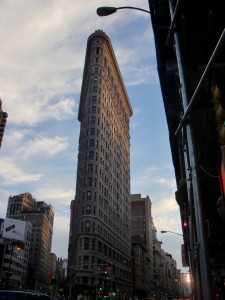
Flatiron Building

Empire State Building
We rented an AirBnB apartment in East 81st Street and I spent the time writing, shopping and wandering that wonderful city with Vicki. Air BnB is so weird. The girl left all her clothes in the wardrobe and food in the freezer. But it was a sweet studio apartment with a garden in a great area, so no complaints from us. The apartment was around the corner from the most expensive Deli in the world (IMHO), Eli Zabar’s, which has the most amazing food and we spent far too much money!

I have never seen such cheese!!
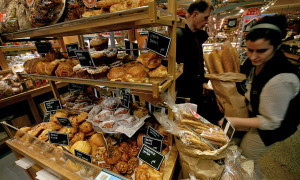
And the bread… But they couldn’t guarantee that the bread on a Sunday was kosher. It might be … or it might not be – eat at your own risk. As a lawyer, I appreciated the delicacy of the exemption clause.
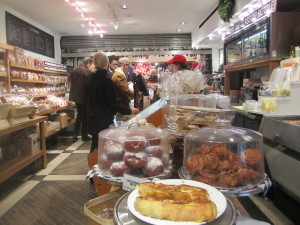
And the cakes were mmmmmm….
The weather was sublime – warm sunny days – and most mornings I would walk down to the Grolier Club, where Toby was working, to join him for lunch in Central Park, by the Boating Lake.

We loved to watch the model yachts on the lake

Central Park in Autumn is gorgeous
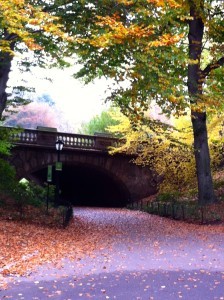
In Central Park
Just as in 2014, we were in New York for Halloween. They take it very seriously in the US, with many houses ghoulishly decorated in our neighbourhood:
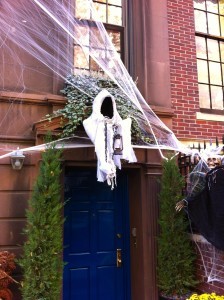
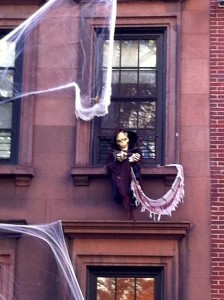
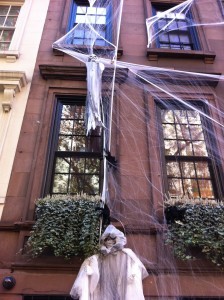
And pumpkins were everywhere:

pumpkins alone …

with flowers
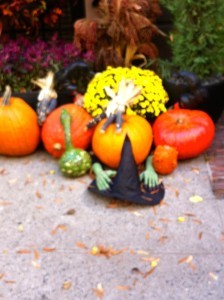
And with a witch’s hat
On Halloween night we went with my cousin Vicki to see the parade. It was a delightful mish mash of people in costumes. And here is a selection of the photos we took:

Elvis lives!!
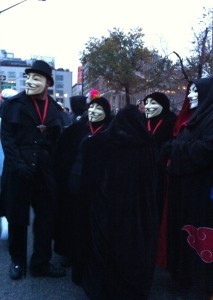
V for Vendetta
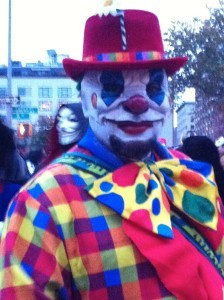
I find clowns particularly creepy…
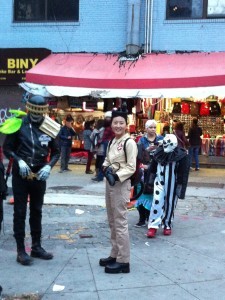
Who ya gonna call?

Tintin meets the Wicked Witch of the West

Rubic’s cube?

An interesting pairing.
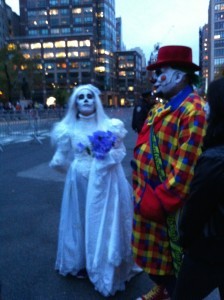
That clown just keeps getting creepier.
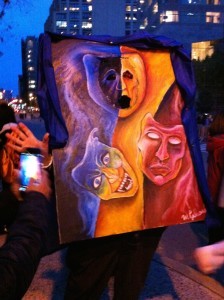
Hmmm
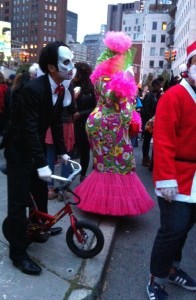

Those muscles aren’t real!!

She’s a fickle corpse bride
We were in NY for the New York Marathon on 1 November, which passed by a couple of blocks from us, and we spent an hour watching the runners, cheering any Aussies and enjoying the spectacle. These aren’t my photos, but give an idea of the immensity of the thing:
These are our photos – the pack had spread out somewhat by the time it reached our neighbourhood:

The only really rainy day we were there was the day we took the train out to Tarrytown to see Joan Osborne in concert, along with Mavis Staples.
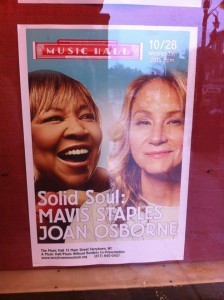
They performed in a delightful old concert hall built in 1871. It is the oldest theater in Westchester County that is still used as a theater. In 1901 it was one of the first theaters to show the new-fangled form of entertainment called motion pictures.
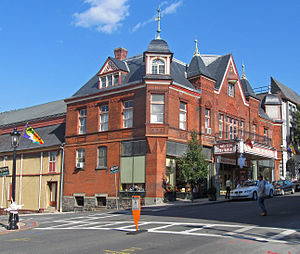
Tarrytown Music Hall
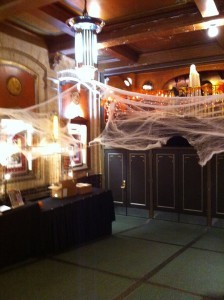
And inside the lobby it was spookified for Halloween
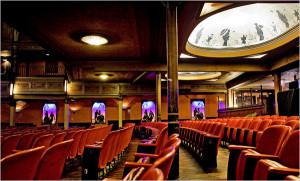
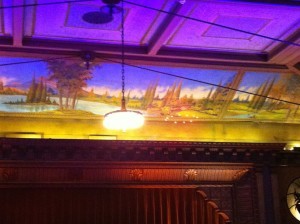
There is a beautiful mural over the stage
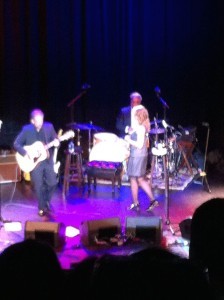
Joan Osborne in concert
We’ve been to NY several times before, so there wasn’t much sightseeing. Still we did mange to see the original Batmobile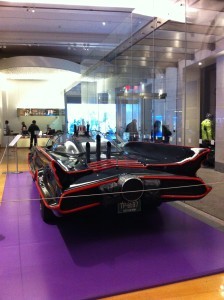

And a squashed Spiderman in Wall Street:
Here we are outside the Museum of New York, with Abe Lincoln dressed as Hawkeye for Halloween:
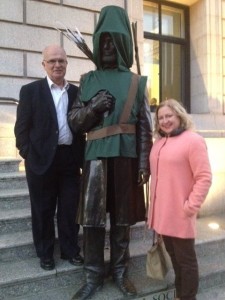
My cousin said that my pink coat was too bright for New York and I should have been wearing black…
One day we went down to the Battery and took a ride on the Sea Glass Carousel, which is surprisingly magical: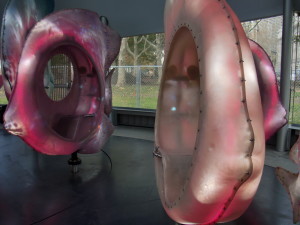
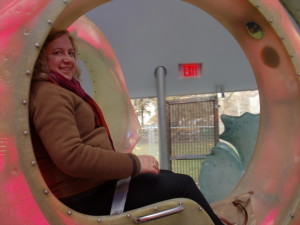
A highlight was attending a production of Arthur Millar’s A View from the Bridge Lyceum Theatre on Broadway. The production was transported from the West End in its entirety to New York and has been getting rave reviews. One of the stars is Nicola Walker (from Spooks, etc.) and her mother-in-law is our neighbour here in Iffley. So we got to go backstage after the show and meet her.
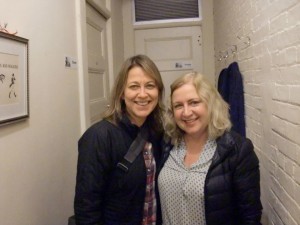
Me and Nicola Walker (who – about 15 minutes before – had been drenched in blood at the climax of “A View from the Bridge”!)
Another highlight was when we visited the best bagel shop in the world, near Tompkins Park. They make the bagels as you watch and you choose anything you want to have with them.
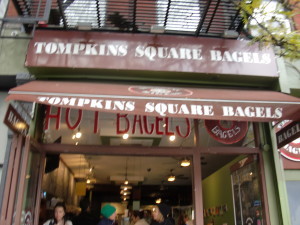
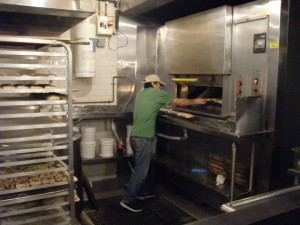
Then we ate our bagels in Tompkins Park and watched the hand puppet give advice:
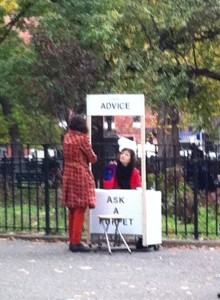
Only in New York
So – that was our New York trip. That brings me to mid-November 2015. I’ll get up to date eventually…
December 7, 2015
Spain and Portugal etc
Dear everyone
Well, people must read this blog, as I’ve had a few emails asking why it has not been updated. The answer is lack of time! I’ve been trying desperately to finish my new novel in between many trips , both overseas and in the UK, and also doing my law work (I’m still working part-time as a long-distance lawyer).
The good news is that the novel is finished!! I sent it to Toby (my husband / proof reader / soft critic / number one fan) yesterday evening for him to look through it.
Now – I had some schtick from a couple of Perth people for the fact that I set the third novel in Melbourne. The reason is that I cannot write ‘to order’. By the time I had finished Taking a Chance I was all ‘written out’ about wartime Perth and wanted a new challenge. When I discovered a very real wartime mystery that was set in Melbourne I was able to use the alchemy of my imagination to write characters and scenes and adventures set around the tragic wartime events.
I loved writing all of my books, and I love writing about Perth, but A Time of Secrets is very special to me as it gave me a new insight into the wonderful city of Melbourne. I was careful to keep Perth connections in the book by having Sandgropers for the two male leads and (as a perspicacious fan wrote to tell me) including as a character Nell’s fiancé from Taking A Chance, and making reference to Tom from Stranger.
The new novel is set in the London Blitz. I have walked the streets of London and I have researched the Blitz extensively in the Bodleian Library here in Oxford. I have bought books about Britain in the war and books written in Britain at that time. I have read diaries, memoirs, novels and histories. I have watched newsreels and movies. I have spoken to those who lived through the war in Britain. It has been wonderfully fulfilling to really enter into that period of British history.
Enough of my writing! What about my travels?
Toby and I went off to Spain and Portugal in October, spending six days in Madrid and six days in Lisbon. I adored them both for different reasons. Madrid is regal and modern and beautiful. Lisbon is friendly and easy and by the ocean, which I love.
I do love Madrid. It helped, though, that we were staying in a lovely nineteenth-century hotel, the Atlantico.
There was a lot going on and the weather was excellent. One morning we saw a procession of the Royal Guard and a Royal Coach.
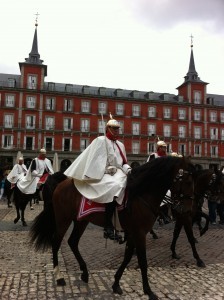
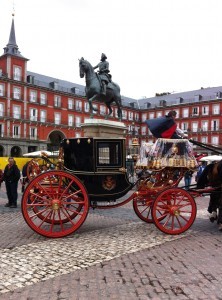
What we particularly liked was the practical Spanish solution to horse dung:
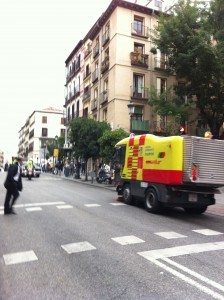
This little street-sweeping machine followed the procession all the way to the palace, weaving behind the horses to keep the roads clear.
We also spent an afternoon at the Prado, the fabulous Art Gallery that has its own Mona Lisa:
https://www.museodelprado.es/en/
The following day we wandered through the beautiful Royal Palace.
Inside, it is sumptuous – but photos of the collection are banned. I did get the ceiling, though, and Toby photographed me on the elaborate stairwell.
 :
:

Star Wars fever is even in Madrid
We took tea at the Thyssen art gallery after seeing its exhibits.
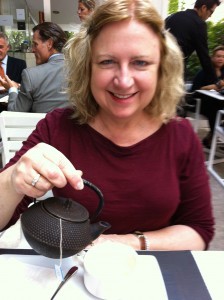
A civilised cup of tea in an art gallery cafe
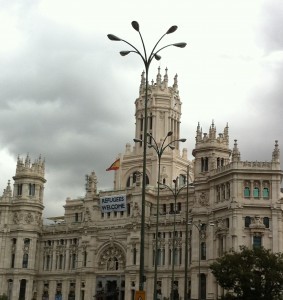
An interesting sign at the Town Hall (formerly the Telephone Exchange) – one you’d not see in Oz.
When Toby gave his talk at the university I discovered that many shops (including the Zara flagship store) are very close to our hotel, which meant I just had to go shopping…
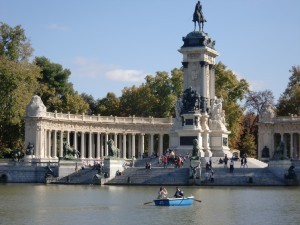
We spent a lovely sunny day in the Retiro – Madrid’s beautiful park.

Also in the Retiro
And of course, we went to a little nightclub to see some Flamenco:
And we were delighted to meet Toby’s uncle, who has lived in Madrid for fifty years, for a drink at the rooftop bar of our hotel.
From Madrid we flew to Lisbon, which is on the coast and I had the scent of the sea again.
A highlight of our visit was the Tile Museum. Tiles are everywhere in Lisbon, but the collection in the museum – an old convent – is spectacular:
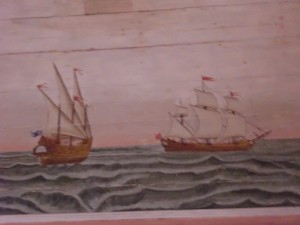
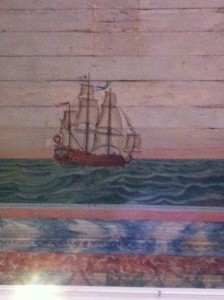
I particularly like the way they portrayed cats…
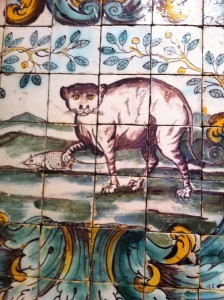
One day we took the train out to the royal palaces of Sintra. Most rooms of the old Palace in Sintra are decorated with polychromed tiles specially made in Seville, and as they bear Islamic motifs they lend an Arab feeling to many of the rooms.
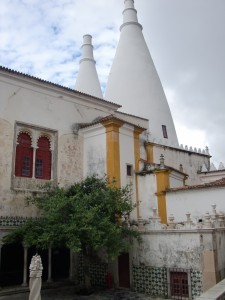
The strange towers are chimneys from the kitchens!
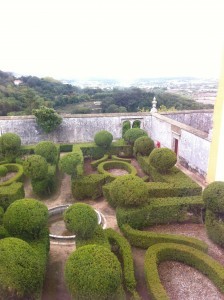
Up, up the high hill is the estate of Quinta da Regaleira. It is classified as a World Heritage Site by UNESCO within the “Cultural Landscape of Sintra”. The palace and chapel are almost ridiculously romantic. The park around it features lakes, grottoes, benches, fountains. But we saw none of that, as it was a cold, wet, misty day when we were there.
And then home to Oxford.
On 14 October we went up to London to see ‘Photograph 51′ – the new play about Rosalind Franklin, who was instrumental in identifying DNA’s double helix.
http://www.theguardian.com/stage/2015...
After the play we met up with a friend who is actually related to Ms Franklin and through her we met a 91-year-old former physicist now turned art historian who had known Rosalind when he was a post-doctoral student at King’s College London in the early 1950s. He didn’t like the way she was portrayed, but Toby and I enjoyed it the play very much.
And afterwards we went out for a drink with friends at the White Swan Inn in Covent Garden, which is mentioned in Dorothy Sayers’ ‘Murder Must Advertise’. A very nice old pub.
Toby was thrilled when we saw Squeeze at the New Theatre in Oxford – still making great new pop music after 35 years!
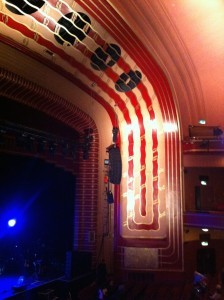
The amazingly Art Deco New Theatre in Oxford

Squeeze in full flight
And we had a delightful visit from Toby’s niece, Ellie. We took her on a visit to to beautiful Bibury in the Cotswolds and to Blenheim Palace, which is in our back yard, so to speak:
This afternoon we are off to Cambridge for a few days, and the following week to Sheffield. But more of that later.
Next time it’s New York and Southampton.
October 18, 2015
Ireland, Spain and Portugal – part one, Ireland
I’m at 85,000 words in the Blitz novel and the end is in sight. I’ve been writing in airport lounges, on aeroplanes, in hotels and in cafes, as we’ve been travelling and travelling and travelling. It’s a good thing I can write anywhere…
It was lovely to visit Ireland again. We started in Dublin, where Toby had a workshop to attend at Trinity College, Dubin. We stayed in a lovely hotel near the University and while Toby was at work on the Friday I took a walking tour around the city. A very tall PhD student was the guide, and he was very knowledgeable and had memorised quotes and aphorisms galore, and I learned a lot about the history of that beautiful city. He told us that apparently Ireland is now officially out of recession. He seemed sceptical. In the last few years, or so he said, 800,000 people had left Ireland seeking opportunities overseas. That in a population of a little less than 5,000,000! What interested me was that when he gave statistics or referred to Ireland, it was always ‘this island’, in other words, he always included ‘the north of Ireland’. I asked him what he thought the future held, and his view was that as the rampant Ulstermen got old and died off, the north would eventually just be subsumed into the Republic of Ireland. There are another 1.8 million people in Northern Ireland.
We started our tour at Trinity College, which was filled with students for freshers’ week.
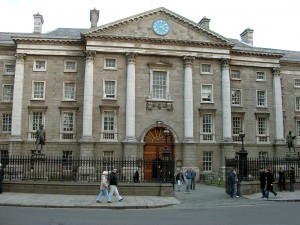
Trinity College Dublin
Across the road to the old Parliament House of Ireland, a really beautiful building that was sold and turned into a bank in 1803. It was the first purpose-built Parliament House in the world and when it was constructed in the 1730s, Dublin was the second city of the British Empire. Britain became fearful in the “Year of the French” in 1798. It was then that the United Irishmen, under Wolfe Tone, tried to convince Ireland to rise up against England with the support of the new French Republic. He failed. When he landed with a French expeditionary force, it was a disaster.
In 1800 the British parliament ‘persuaded’ the Irish parliament to vote to disband itself and devolve power to Westminster – our guide likened it to a turkey voting for Christmas. The beautiful former House of Lords, with its coffered ceiling, chandelier, oak panelling and two tapestries which depicted the Battle of the Boyne was kept intact by the bank, as a board room.
In O’Connell Street we saw the statue to Daniel O’Connell, the Great Emancipator of Ireland in the decades after Wolfe Tone. He was enormously popular and successfully campaigned for Catholic emancipation, and achieved it in 1829. In 1841, O’Connell became the first Roman Catholic Lord Mayor of Dublin since the reign of James II in the 1680s (James had been the last Roman Catholic monarch of England, Ireland and Scotland.)
He was utterly opposed to violence, having killed a man in a duel in 1815. So it’s ironic that his splendid monument is riddled with bullet holes from Irish uprisings that occurred in the twentieth century. If you look closely at the statue of the angel you can see a bullet hole under the drapery to the right – a legacy of Ireland’s troubled history.
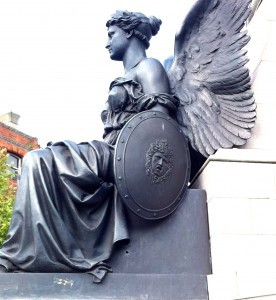
Part of the O’Connell memorial in O’Connell Street

The Ha’penny Bridge over the Liffey
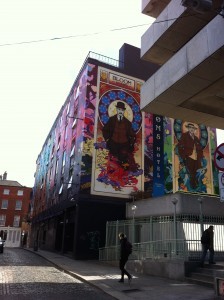
The beautifully decorated Bloom Hotel in Temple Bar
We visited trendy Temple Bar and then went to Dublin Castle, which has been in continuous occupation since it was built in 1204. It was the official seat of British government in Ireland and the symbol of British supremacy for centuries. In 1922, Michael Collins accepted the surrender of the Castle when the Irish Free State was formed.
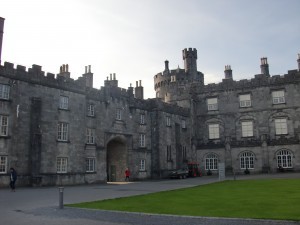
Dublin Castle
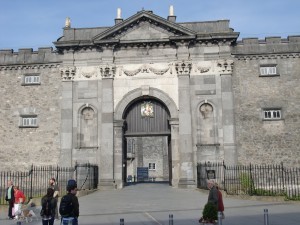
Entrance to Dublin Castle
Our guide pointed out the positioning of the statue of Lady Justice, who does not face out towards the people, but looks inward, towards the Castle. Hence the rhyme, which he quoted:
“The Statue of Justice, mark well her station,
her face to the castle and her arse to the nation!”
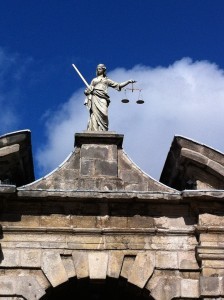
Justice – facing into the Castle, with her back to the people of Dublin
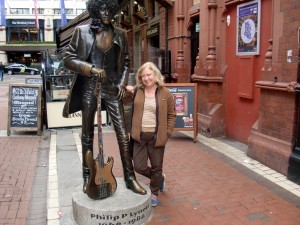
Me and my mate, Phil Lynott
And we visited the City Hall, formerly the Customs House.
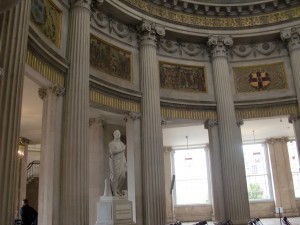
For my lovely Agent, Sheila – a statue of Thomas Drummond, in the City Hall. A relative?
We also saw the beautiful Book of Kells, which (according to my PhD guide) brings in 6,000,000 euros a year to Trinity College through the hordes of visitors.
Book of Kells Facts: It attracts over 500,000 visitors annually. The manuscript has 340 folios. It is written on calf vellum, with lettering in iron gall ink. The colours were imported from far away lands and are made from plant and animal pigments. It is named after the Abbey of Kells in Co Meath where it lived for centuries. The ms was never finished, but what there is may be viewed on the Library’s Digital Collections portal.
Upstairs is the beautiful Long Room, which dates from the 18th century, and houses 200,000 of the Library’s oldest books in its oak bookcases.
We left Dublin on Saturday in a hire car and drove down to the pretty little village of Stradbally in Co Waterford, to stay in a cottage belonging to a friend of ours, who inherited it from his aunt. I’m standing in the doorway of the green cottage in my pink coat – what colour co-ordination, you gasp. The row of cottages date back to the early nineteenth century and our cottage was just perfect. We were met by the delightful neighbour Eileen, who is the holder of the keys, and we waved to the delightful Eileen, the other neighbour who apparently knows everything there is to know about Stradbally.
Stradbally is on the “Copper Coast” road, and it is a picturesque village of neat thatched and slated cottages. It wasn’t surprising to hear that it has won numerous awards in the National Tidy Towns Competition as the residents keep it immaculately. It is surrounded by trees – these were first planted by the Fitzgeralds in the 18th century, and as the guide book says, they ‘give the area an unusual tamed, sylvan character which contrasts with the wild stretches of windswept coast’.
Two coves are within walking distance of the village. Stradbally Cove has a pretty river flowing into it and a sandy beach. It would be ideal for swimming (if you could bear the freezing water) but, sadly, the signs warn against bathing there because it is polluted by the village’s sewage works.
A few miles down the road, at the end of a pleasant walk, is rugged Ballyvooney Cove, spectacularly set under a dramatic headland. It has a pebble beach.
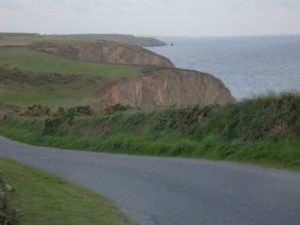
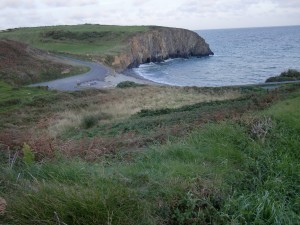
The Church of Ireland church in the village has in its grounds a substantial ruin of the largest medieval church in rural Ireland. It contains a fortified presbytery, probably built for protection during the disputes between the Powers and Fitzgeralds, whose boundary lands ran through the area.
We went for a drive the next day, into the ruggedly beautiful Comeragh Mountains. The twelve mountains which form the group are very popular for mountain climbers and hikers, as we found out when we went to visit the waterfall. The highest point in the Comeraghs is 792 m (2,598 ft).
And we drove to pretty Dungarvan for lunch by the harbour. The town stands at the mouth of the Colligan River. Sadly, while we were there someone cannoned into our hire car, which was parked on the street, and scraped the side badly. I must say that the Irish are dreadful drivers!!! I really think they may be worse than Perthites, which is astounding. But maybe it’s because there is so little traffic on the roads. It was really lovely to have beautiful scenic roads almost to ourselves – compared with crowded England.
And from there to Lismore Castle gardens, which were a picture of early autumn beauty. The stately home (which is not open to the public) has belonged to the Dukes of Devonshire since 1753. The present Duke’s son, Lord Burlington, is in residence. In the gardens we found the deliciously creepy Yew Walk, where Spenser thought up some of The Faerie Queene.
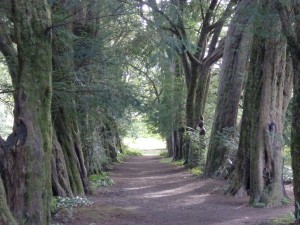
The Yew Walk
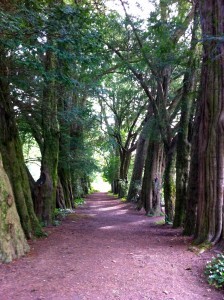 Perhaps it was the inspiration for this canto:
Perhaps it was the inspiration for this canto:
Enforst to seeke some covert nigh at hand,
A shadie grove not far away they spide,
That promist ayde the tempest to withstand:
Whose loftie trees yclad with sommers pride
Did spred so broad, that heavens light did hide
Everywhere now there are apple trees laden with fruit, and Lismore was no exception. The trees really are so lovely, with their red jewels of apples peeping out from gnarled branches.
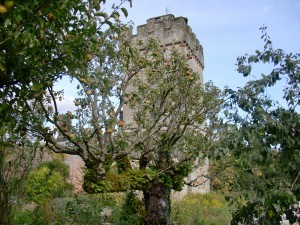
“What wond’rous life in this I lead! Ripe Apples drop about my head”


A love seat bought for the wedding of Lord Burlington.
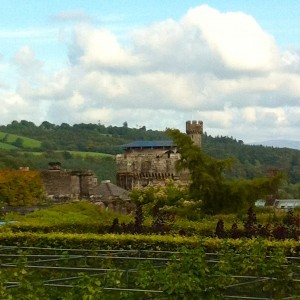
Not Tuscany, but Waterford…
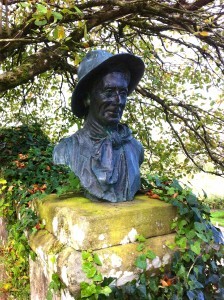
A statue of the Irish Gardener

Especially for Carolyn – spot the cat!!

The photographer at work!
On Monday we drove into Toby’s mother’s mother’s ancestral home, Waterford – the oldest town in Ireland. Toby’s family were cattle traders in the town. Viking raiders first established a settlement near Waterford in 853, but were driven out by the native Irish in 902. The Vikings returned in 914 and this time they stayed until 1170, when Diarmait MacMurchada, the deposed King of Leinster, took Waterford with the assistance of the Norman Earl of Pembroke, known as Strongbow.
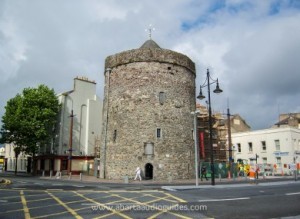
Reginald’s Tower
We visited a museum in what used to be the Bishop of Waterford’s Georgian house, and also saw medieval exhibits in what used to be the cellars of a medieval merchant’s house. This is a Viking stone tower (Reginald’s Tower) on the long and impressive quay.
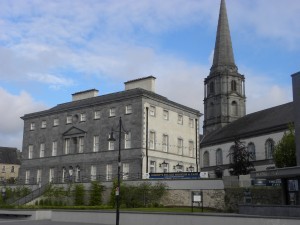
Bishop’s House museum
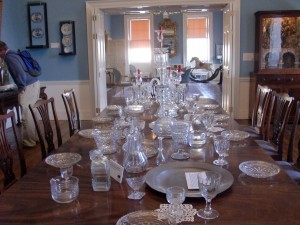
Biggest exhibition of old Waterford crystal in the world is in the museum
The next day it was off to Kilkenny, where we visited the castle.
On our last day in Ireland we visited Curraghmore, the seat of the Marquis of Waterford. The house itself looks forbiddingly gothic. It’s actually a Norman keep encased in a Victorian mansion. A castle was erected on the site in the twelfth century, but the core of the current house is a medieval tower-house, which was extended in 1700 when a house was built around a court and the medieval tower-house was incorporated at the north-eastern side. The De La Poer family have been there since 1167, but they became the Beresfords in the eighteenth century, and it was then that a forecourt with stables was added and the house was refurbished in the 1780s. Curraghmore House is surrounded by 2,500 acres of formal gardens, woodland and grazing fields, which makes it the largest private demesne in Ireland.
There was a lovely little shell grotto built in the gardens by Catherine, Countess of Tyrone in 1754. The shells are from all over the world and she got them from sailors who docked at Waterford.
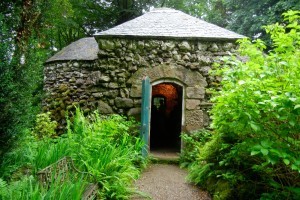
The shell grotto
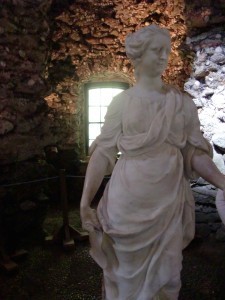
The Countess in her grotto.
On the castle keep, looking down on visitors, is a St Hubert’s Stag, a deer’s head with a cross between its antlers:
The caretaker/guide told us that the stag saved the house from burning in the 1920s. The IRA had straw along the top of the house ready to set the match. But there was a full moon over the lake and it shone onto the cross which shone onto the courtyard. The man who was about to light the bales thought this was a sign from God so didn’t light the bales. And so the house is still standing.
They left Curraghmore and on that same night burnt the Woodstock House in Inistioge, Co. Kilkenny. The guide told us that Woodstock House is now simply a beautiful garden around a ruined house.

Curraghmore Castle
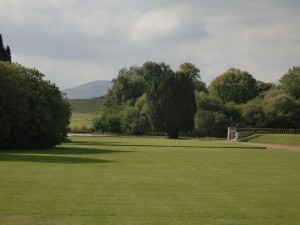
It was getting late by the time we left Curraghmore, so we drove hell for leather to the airport . . . to just miss the plane. Not to worry – it was then we discovered that we’d left our passports in the hotel safe in Dublin when we’d departed for Waterford four days before.
A hurried phone call to the hotel ensued. The girl on the desk asked if we could wait until the maid saw to the room the next morning. She was told, no we couldn’t. She said she’d send someone to check the room. We thanked her, and sat at the airport, surrounded by our luggage, wondering if the passports would still be in the safe.
The phone rang and a young man from the hotel told me, ‘I’m delighted to tell you that I’ve your passports in me hand right now. I’m looking at them.’
At our request, he sent them to the airport by taxi, and when Toby picked them up outside the terminal the taxi driver said, ‘You’d be surprised how often I’ve had to do this.’
We got the 11.00 plane back to Birmingham and were in Oxford by around 1.00am.
Four days later and we flew to Madrid, but that’s another story…

